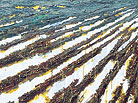Zbigniew Blukacz — beyond the skyline (painting)
catalogue ‘Zbigniew Blukacz — beyond the skyline’ “Existential condition of contemporary artists has perfectly been expressed by Krystian Lupa, the director: ‘The world to the man has ceased to be...

(…) Blukacz comes down from heaven to earth and takes up landscape painting. Nothing more than this. The motif is radically narrowed down. The artist is harsher on himself than the post impressionists who, in their aspiration to detach painting from literature, limited themselves to landscape, still life and portraiture.
Tapering the motif did not lead to oversimplification, the author did not adopt an affected style. He ventured into the depths of painted landscape the same way other people go into the real three-dimensional space of actual landscape, where one keeps noticing something new, where the background becomes the foreground, and this turns into details, and a moment later their mutual relationships and hierarchy of importance get reversed, and again the near becomes the far, the big has decreased, and the important has lost its privileged position. He studies landscape, its structure and principles, and at the same time enters the structure of a painting.
He comes down to earth, in both the metaphorical and literal meanings. The space or more pictorial-immaterial expanse of the sky is taken up by concrete. The indefinable, deprived of shape and local flavour, has to give way to that which is, at least theoretically, perceptible, which is subject to three dimensions, has its colour and texture, weight and density. And this is the artist's only revolutionary change. Ever since, this change has continued to evolve, in its relentless striving for perfection. It is precisely at that moment that the artist's specific and distinctive landscape was born. Always different, but also the same, as it is a reflection of the same personality, his ideals and dreams. (…)
Zbigniew Blukacz's art can be succinctly referred to by the term 'elocution of silence', which covers the nostalgia and surrealist poetry held in the strict reins of geometrical netting, spread like a backbone under the tissue of the actual painting. Also, his good taste, leading to what the French call peinture-peinture, painting which can exist without an anecdote, because it is attractive and meaningful, and therefore self-sufficient. Finally, Georges Buffon (another French connection in this context) said that style is a man, and this observation is equally pertinent in our times.
Jerzy Madeyski






